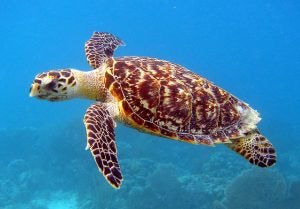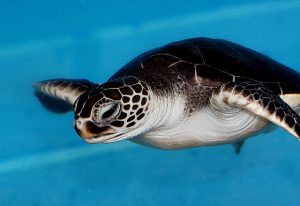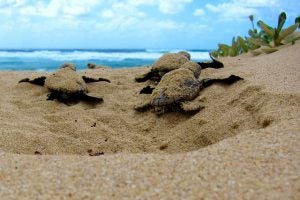
Sea turtle populations are showing promising signs of recovery after years of decline. (Photo credit: U.S. Fish and Wildlife Service Southeast Region)
There’s some good news in the animal kingdom. Sea turtles, the beloved green jewels of the world’s vast blue oceans, appear to be bouncing back after decades of decline.
Six of seven sea turtle species are currently listed under the U.S. Endangered Species Act (ESA) – the green, loggerhead, Kemp’s ridley, olive ridley, hawksbill, and leatherback – and many of them have been on the list since 1970. Since then, conservation efforts have made significant strides in protecting nesting beaches, reducing mortality in fisheries and establishing marine protected areas.
Recent research suggests there is hope for beleaguered sea turtles. Important recovery in some local populations has shown that we can turn things around for sea turtles, especially with effective endangered species policy and improved management.
This comeback is promising, not just for turtles, but also for marine ecosystems and the marine economy at large.
Multiple threats and early successes

Sea turtles have been on planet Earth since the time of the dinosaurs – about 110 million years. (Photo credit: Bernard Spragg)
Sea turtles are used to a challenge. Only 1 in 1,000 hatched babies survive to adulthood once they’re in the ocean. From there, they are exposed to multiple threats including deaths from accidental entanglement in fishing gear, destruction of nesting beach habitat, and legal and illegal harvest of adults and eggs. Climate change impacts loom as well. As a result, populations overall have been reduced by approximately 95 percent from original levels.
Historically, one of the biggest threats to sea turtles was direct harvest of eggs and adult turtles for food, which increased steadily until international trade of most species of sea turtles or their eggs became illegal in 1981 under the Convention of the International Trade in Endangered Species (CITES). CITES and ESA protection have significantly reduced sea turtle deaths over the years.
The commercial fishing industry has posed a critical threat to sea turtles. Kemp’s ridleys were especially hard hit, caught and drowning in fishing nets in the Gulf of Mexico.
In the 1990s, EDF worked with fishermen and managers to develop and adopt gear modifications that have significantly reduced turtle mortality. These gear modifications included turtle excluder devices (TEDs) – specialized nets that work by releasing larger marine organisms through a trap door, while still collecting shrimp. TEDs have helped to lessen sea turtle casualties, while careful husbandry of hatchlings on nesting beaches have helped enhance reproductive success.
A success story in the making
Thanks to effective policy protections and fishing innovations, there has been a marked improvement in some sea turtle populations. In some places, green turtle populations are nesting in record numbers. Hawksbills have reappeared in Honduras, El Salvador and Nicaragua. Leatherback numbers are increasing in some places.

Sea turtles are an essential part of beach and dune ecosystems. (Photo credit: Jeroen Looyé)
A recent study shows that globally, where data are adequate to detect trends, increasing nesting populations exceed decreasing nesting populations. The health of many sea turtle populations remains unclear. Nonetheless, this comeback is promising, not just for turtles, but also for marine ecosystems and the marine economy at large.
Sea turtles provide many ecosystem benefits
Sea turtles are essential elements in coral reef, sea grass and mangrove ecosystems. Turtles help maintain sea grass beds, which also provide habitat and nurseries for a wide variety of fish and crustaceans that are harvested for human consumption and support large fishing economies.
On beach and dune ecosystems, sea turtle eggs provide otherwise limited nutrients – from unhatched eggs or leftover shells – that improve vegetation growth.
Sea turtles also offer a number of opportunities for people – locals and tourists, children and adults – to learn more about wildlife and the ocean. From North Carolina to Florida and around the Gulf, people frequently participate in night watches on beaches, hoping to spot turtles crawling ashore to lay eggs, or baby sea turtles hatching and scrambling towards the sea. It’s inspiring to see these creatures and to know that citizens are doing what they can to help protect these vulnerable populations.
With a winning combination of smart policies, industry action and citizen interest, the incipient sea turtle success story is one that should continue to instill pride in the policymakers, fishermen, and individuals who are working together to help save these delicate, ancient, and iconic species.
This blog was co-authored by Doug Rader, Chief Oceans Scientist at EDF.
Related:
Dear Congress, protect the integrity of the ESA >>
The secret survival of the “masked bandit” in the vanishing prairie>>
How the fastest American raptor nearly nosedived into extinction >>









